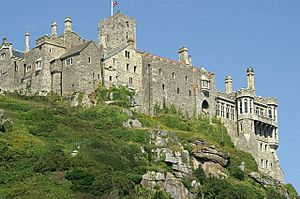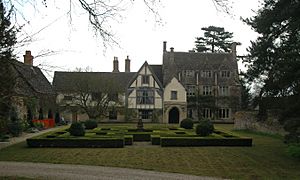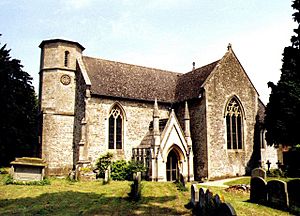Lady Catherine Gordon facts for kids
Quick facts for kids
Catherine Gordon
|
|
|---|---|
| Born | c. 1474 |
| Died | October 1537 |
| Buried | Church of St. Nicholas, Fyfield |
| Noble family | Clan Gordon |
| Spouse(s) | Perkin Warbeck James Strangeways Matthew Craddock Christopher Ashton |
| Father | George Gordon, 2nd Earl of Huntly |
| Mother | Elizabeth Hay |
Lady Catherine Gordon (born around 1474, died October 1537) was a Scottish noblewoman. She became famous as the wife of Perkin Warbeck, a man who claimed to be Richard of Shrewsbury, Duke of York, a lost prince. After King Henry VII of England captured her, she became a trusted lady-in-waiting to his wife, Queen Elizabeth of York. Lady Catherine married four times, but there are no records of her having any children who survived.
Contents
Who Was Lady Catherine Gordon?
Lady Catherine was born in Scotland. Her father was George Gordon, 2nd Earl of Huntly, and her mother was Lady Elizabeth Hay. Some writers in the 1800s thought she might have been the daughter of King James I's daughter, Annabella of Scotland. However, this was not correct.
Her Marriage to Perkin Warbeck

Before March 4, 1497, Lady Catherine married Perkin Warbeck. King James IV of Scotland supported Warbeck for political reasons. It seems Warbeck had been trying to win her over since 1495. A copy of a love letter from Warbeck to Lady Catherine still exists today.
King James IV gave Perkin Warbeck a special white silk gown for their wedding in Edinburgh. The wedding celebrations included a tournament, a type of knightly contest. Warbeck wore armor covered in purple fabric.
Lady Catherine was now called the Duchess of York. She sailed from Ayr with Perkin on a ship called the Cuckoo. She wore a new brown "sea gown." In 1497, King Henry VII's army captured Warbeck's forces in Exeter. Lady Catherine was taken prisoner at St. Michael's Mount. On October 15, 1497, Robert Southwell was paid money to arrange horses and other things to bring "my Lady Kateryn Huntleye" to London. Her husband, Perkin Warbeck, was executed on November 23, 1499. King Henry kept Lady Catherine as a kind of guest, placing her in the household of his wife, Queen Elizabeth of York. She became one of the Queen's favorite attendants.
Life as a Widow
King Henry VII helped pay for Lady Catherine's daily costs and gave her gifts of clothing. The royal records often called her "Lady Kateryn Huntleye." These gifts included fancy gowns made of velvet and fur. She received clothes made of cloth-of-gold and velvet. In January 1503, Catherine attended the wedding ceremony of King James IV of Scotland and Margaret Tudor at Richmond Palace. James IV was represented by the Earl of Bothwell.
In February 1503, Lady Catherine was a mourner at Queen Elizabeth's funeral. She arrived in a special carriage with other noble ladies. The long train of her dress was carried by the Queen's mother-in-law, Margaret Beaufort, Countess of Richmond and Derby. Lady Catherine made offerings during the church services. She also helped place a special embroidered cloth on the Queen's coffin at Westminster Abbey.
In 1510, Lady Catherine gained official permission to live in England as a citizen. That same year, she was given control of two estates, Philberts and Eaton. Two years later, she and her second husband gained control of the Fyfield estate. She was allowed to keep these estates as long as she did not leave England without permission.
Later Marriages and Death
Before February 13, 1512, she married James Strangeways of Fyfield. He was a gentleman who served in the King's Chamber. The couple arranged for a priest to pray for their parents' souls at Southwark Cathedral in London.
In 1517, she married her third husband, Matthew Craddock of Swansea. He was a powerful official in Wales and died around July 1531. Matthew Craddock's will (his last wishes) listed the jewels and silver Lady Catherine owned before they married. These included a fancy belt with a perfume holder, a gold heart, and a gold cross with diamonds. He left her money from lands near Cardiff.
Her fourth and last husband was Christopher Ashton of Fyfield. Lady Catherine is not known to have had any surviving children of her own. However, she gained two stepchildren from Ashton's previous marriage.
According to a writer named David Loades, Lady Catherine was in charge of Mary Tudor's private household until 1530. When she was not at court, Catherine lived at Fyfield Manor. During her marriage to Craddock, she had permission to live in Wales. Catherine wrote her will on October 12, 1537, and died soon after.
Catherine was buried in the church of St Nicholas at Fyfield. Her tomb once had brass figures, but they are now lost. Matthew Craddock had already built a tomb for himself and "Mi Ladi Katerin" with their statues in St Mary's Church, Swansea. The carvings on the tomb included symbols of the Gordon and Hay family. Both Catherine's mother and her grandmother on her father's side were members of the Hay family.
Lady Catherine in Books
Lady Catherine Gordon is an important character in Mary Shelley's historical novel, The Fortunes of Perkin Warbeck (1830). Her capture is also the topic of a historical poem by James Hogg, called The White Rose o' Scotland. This poem was first published in a magazine in February 1834.



